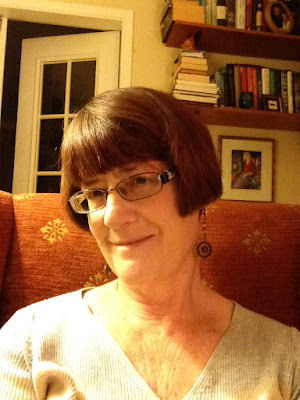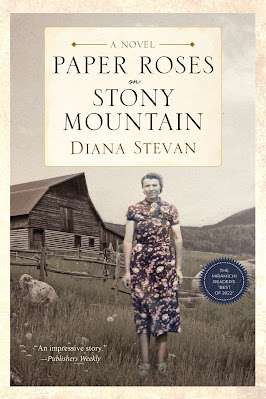Please welcome Carrie to the
Scribbler. It is her first visit and we hope it won’t be the last.
Not only does she write stories, she is also an active reviewer for The Miramichi Reader. She is a kind and generous supporter of her fellow authors.
Read on my friends.
Carrie Stanton has published two picture books and two chapter books. Emmie and the Fierce Dragon, The Jewel, Beast Bot, and The Gardener. The Jewel is used in schools as a companion to First Nations study. Carrie has a BA from the University of Calgary and is an editor at The Miramichi Reader (TMR). And, like TMR, Carrie is devoted to Canadian Literature. Carrie has two adult children, a daughter-in-law, one grandson, one mother, one husband, and a small white dog who incorporates many personas.
Carrie enjoys writing stories that allow the imagination to blossom. She loves how words can grow wings and transport readers great distances, to worlds where anything is possible.
Carrie is proud that many schools often use her books for classroom study, engagement, and conversation. Her books are local #1 bestsellers, have been staff-picked at Chapters and Indigo, and are loved by parents, teachers, and children globally.Titles: Emmie and the Fierce Dragon & The Jewel.
The story behind the story: I knew something was going on when I had a cacophony of words inside my head. They were in there rumbling around, loudly causing distractions.
I decided to sit still, pen in hand, blank pages at the ready, to see
what all the mental chaos was about. That’s when the two stories started to
evolve. A picture book and a chapter book. Emmie and the Fierce Dragon and The
Jewel emerged, almost simultaneously. I wrote Emmie and the Fierce
Dragon first, then immediately began The Jewel. With The Jewel,
I had the story outline but knew I needed to research the setting. The perfect
place to do that was at The Glenbow Museum Library and Archives, located in Calgary,
the city in which I live. After all, how else could I possibly get an accurate
picture of life in the foothills of the Rocky Mountains in the mid-1800s?
Securing a table in the museum’s library, I requested the material I hoped
would uncover life during a time unknown to me. Not being allowed to select the
diaries, journals, and notes from explorers who recorded their findings of the
area, I asked the gloved library attendant if I could go over some of these archived
works at my table. Bringing pieces out of the collections kept securely away
from seeking hands, I was rewarded with a cache of wonderful and enlightening
notes and documents from an era long past. Reading through these carefully
written works was absolutely necessary to be able to create the world I wanted
to bring alive in The Jewel. Knowing my characters Grey Wolf and Little
Bear very well, I had to make certain they were at home in this story.
Incorporating the colourful Indigenous life into the adventure story of these
two best friends made it historically accurate and vibrant. It is a homage to
the beautiful First Nations of the land we now call home. Because of the
journals and diaries left by those before me, I could incorporate the backdrop
into The Jewel. The added bonus is that renowned Canadian storyteller,
poet, and novelist, Lee Maracle, granted me permission to use her grandfather’s
words in The Jewel. Chief Dan George’s words are few but striking in the
story. I used them with precise care and respected them in the beautiful way
they were meant to be honoured.
With both manuscripts ready, I sent them to only one person, Kathryn Cole, managing editor of Second Story Press in Toronto. I knew her reputation was solid as she had been in the publishing business for decades, at that time. Then I held my breath.
Kathryn Cole responded with a letter saying that she loved both the stories and they should be printed. Their house wasn’t able to do that within their schedule and limitations, but she urged me to keep going. It was at that moment I decided to seek illustrators, professional editors and proofreaders, book designers, and a quality printing house. In other words, if Kathryn Cole, the seasoned children’s book editor had faith in me, I had to get some faith going inside me as well. To my amazement, she offered her words as blurbs on both of the books!
The first stop was deciding to create the picture book, Emmie and the
Fierce Dragon. Who would ever believe that a small girl could help out a
town with a serious fierce dragon problem? Still, Emmie sets off with a plan of
her own to tame that dragon. How many times in our lives must we be faced with
a dilemma that requires each of us to stand tall, be brave, and do the
courageous thing with nothing more than our wits and skills? Even if that meant
our kneecaps could shake down a hillside? Yes, we must, at any age, face a
beast. My daughter, Carly, introduced me to her friend Sonia Leung, a talented
watercolour artist whom she felt could do the job of illustrating. After
reading the manuscript, Sonia agreed to create the fantastic original watercolour
artwork in Emmie and the Fierce Dragon. I loved how Sonia’s work
complimented and brought to life the words I had written; I knew this was
exactly the road I should be on. Seeing the finished product in Emmie and
the Fierce Dragon confirmed this choice was indeed the perfect fit I had
been seeking when the jumble of words first appeared in my head. I could now
give it a name, and that name is STORY.
Emmie and the Fierce Dragon was the first to be introduced into the
marketplace of readers. At the book launch held in Calgary at the city’s oldest
book store, Owl’s Nest Books, a friend of Sonia’s, James Pantuso, approached me
and offered to do some illustrating for any other book I might have in mind.
Well, I did have The Jewel manuscript just waiting for an illustrator.
James created the graphic art that is a stunning example of what an artist can
do with a black pen and a piece of paper. There was one and only one colour
used in that book, purple, and it was used in a very purposeful way. It became
a critical part of the story, appearing and disappearing at the right times.
James and I have gone on to do more collaborations and I am so proud to have
been able to work with such immensely talented artists. Both Emmie and the Fierce Dragon and The
Jewel are Calgary Number One Bestsellers!
Creating the first two books led to two more books. Beast Bot is
a chapter book about a passionate inventor who must decide, after the worst
happens in his family, if he should continue with his passion or give it up and
make some new friends. Beast Bot
is blurbed by Canadian Treasure, poet, storyteller, novelist, and my personal
idol, Sheree Fitch. I was over the moon when she agreed to read the manuscript
and offer her thoughts in a book blurb. Then, it was reviewed by CBC Books,
with host Russell Bowers and Canadian literature advocate and author, Dr. Angie
Abdou. The Gardener is my latest release, illustrated by James Pantuso,
showcasing his talent with a full-colour extravaganza of pictures and a rhyming
singsong story about one’s dreams and imagination, and what happens when those
are lost. How can your dreams and imagination possibly be brought back once
they are gone? The Gardener will help out with that!
Website: Home | Emmie and the Fierce
Dragon
Coffee
or tequila: Both if the situation demands it! Coffee to keep fueled and a wee dram
of Scotch upon completion of a book.
Music or quiet: Quiet so the story music in my
head can storm out and dance onto the paper.
Thank you so much, Allan Hudson, for this wonderful experience with you
and The Scribbler! I had a blast!
You are most welcome, Carrie. Wishing you continued success with your writing.
And a BIG thank you to our
readers and visitors.





























.jpg)






.jpg)

